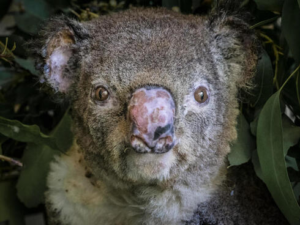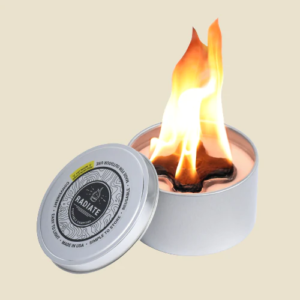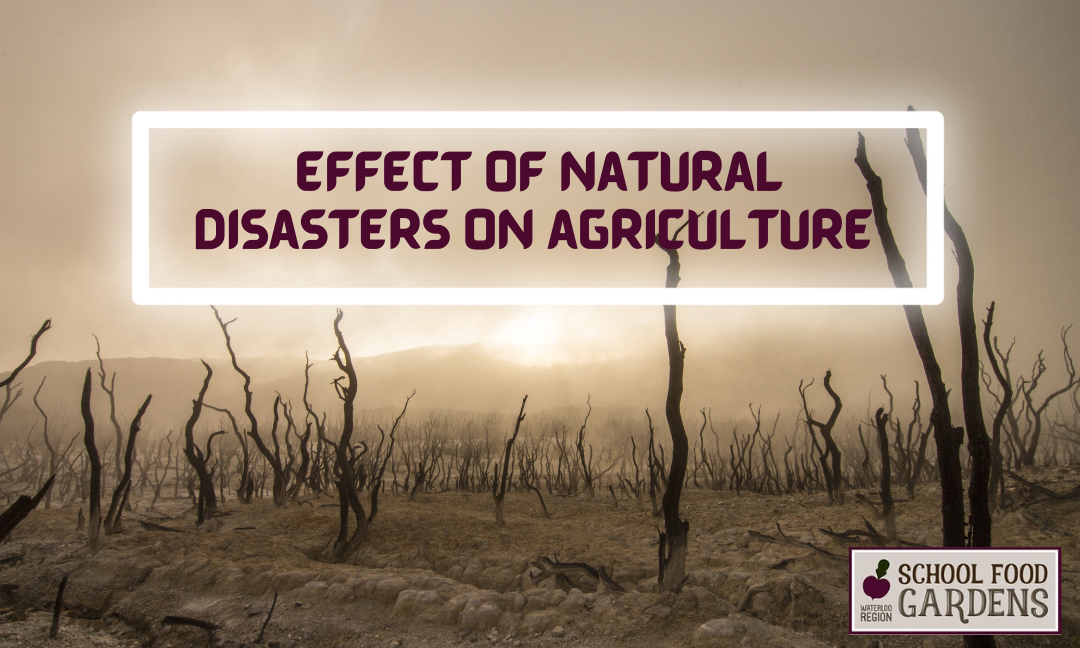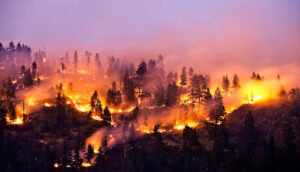Author: Juiee Bhatt
Editor: Connor Fraser
Graphic Designer: Jiya Mehta
Publisher: Rayna Almas
Introduction
Imagine a world with no food production; impossible, right? This is because agriculture is a vital part of our living. Agricultural food productions take place all over the world 24/7; harvesting, yielding, importing, and exporting. However, there is no such thing as a “perfect” growing season. Many factors disrupt the chain of food yielding and production. One of the biggest factors is natural disasters.
Some examples of natural disasters include earthquakes, tsunamis, storms, wildfires, floods, droughts, etc. Natural disasters are caused by the natural processes of the Earth, and are out of mankind’s control. And so — by name — natural disasters cause lots of damage and destruction! Visit my previous blog post to look at the details how to how natural disasters affect the agriculture industry: https://seeds.ca/schoolfoodgardens/effect-of-natural-disasters-on-agriculture-how-can-we-prevent-it/
Meanwhile, in this blog post I will be focusing on the natural disaster of wildfires! In the following paragraphs, we’ll take a closer look at what exactly wildfires are, as well as what causes them.
All About Wildfires
In simple words, wildfires are defined as large, destructive fires. As they ignite and spread in an area, wildfires usually engulf and damage any vegetation in its path. The types of plants it engulfs determine what type of wildfire it is, such as brush fires, bushfires, desert fires, hill fires, peat fires, vegetation fires, veld forest fires, etc.
In fact, these fires can spread at rapid speeds depending on the area it surrounds. For example, in forests, wildfires can spread up to 10 km per hour, whereas in grasslands they can spread up to 23 km per hour! The level of terrain also plays a factor since flames usually travel faster at an upward slope. In addition, oxygen/wind, already-combusted branches, dry and humid conditions such as drought and desertification all contribute to feeding the flame.
In order to determine the severity of wildfires or any natural disasters, cities use some sort of scale. For example, in British Columbia, Canada, a ranking system from 1 to 6 is used (as shown above from the Government of B.C. website), which is especially helpful as British Columbia is very prone to wildfires. The different ranks help response systems identify how the fire is being produced, how it spreads, as well as how firefighters will approach the situation (i.e. tactics). For example, in a Rank 1 fire, which is the least severe kind of fire, firefighters are able to perform direct attack using water delivery systems. Compared to a Rank 6 fire where it is very dangerous for firefighters themselves to be engaged in attack; fire suppression efforts must be made until fire behaviour lessens.

But how exactly do wildfires ignite? Well, 80% of the time, wildfires start due to human activity, such as campfires, burning of trash, fireworks, cigarettes, and arson (setting of fire on property as crime). There are also natural causes of wildfires, such as a volcanic eruption nearby, lightning strike, dry and hot weather, and wind.
Effect of Wildfires on Environment
 As the wildfire spreads across the plants and crops, nutrients and organic value from the soil are stripped, damaging acres of rich, fertile, and arable land; preventing crops from ever growing again. Additionally, lots of greenhouse gases, such as methane and carbon dioxide, are released into the air. This not only contributes greatly to climate change, but also makes the surrounding air harder to breathe. Hence why neighbors may suffer with breathing, which can lead to respiratory-related illnesses (i.e. asthma).
As the wildfire spreads across the plants and crops, nutrients and organic value from the soil are stripped, damaging acres of rich, fertile, and arable land; preventing crops from ever growing again. Additionally, lots of greenhouse gases, such as methane and carbon dioxide, are released into the air. This not only contributes greatly to climate change, but also makes the surrounding air harder to breathe. Hence why neighbors may suffer with breathing, which can lead to respiratory-related illnesses (i.e. asthma).
Combined with this are great losses in biodiversity. For instance, in the 2019 Australian Bushfire Crisis—nicknamed the ‘Black Summer’—approximately 3 billion animals were harmed! This was due to the loss of habitat, destruction, and harm to the ecosystem. Such kinds of events can result in endangerment and possibly extinction of certain animal species!
Any Solution?
 Since humans are the prime causation of wildfires, it’s up to us to make some changes in order to avoid these disasters from occurring. For example, practicing a safe disposal of cigarettes, fireworks, and controlling the ignition of campfires. In fact, there are products on the market which help with such things. For example, a product pitched on the entrepreneurship show ‘Shark Tank’ in 2018 “ignited” its business when striking a partnership deal with one of the investor sharks. Since 2018, their sales have been through the roof from their campfire product called ‘Radiate’. Radiate is a product that helps ignite a regular campfire much more safely than how traditionally done. Made out of recyclable materials, Radiate is easily ignited and lasts hours of burn time! And when your camping fun is done, simply slide the lid back on top and the fire will safely diminish. What’s more? This product is reusable! Visit their website to learn more: https://radiateportablecampfire.com/
Since humans are the prime causation of wildfires, it’s up to us to make some changes in order to avoid these disasters from occurring. For example, practicing a safe disposal of cigarettes, fireworks, and controlling the ignition of campfires. In fact, there are products on the market which help with such things. For example, a product pitched on the entrepreneurship show ‘Shark Tank’ in 2018 “ignited” its business when striking a partnership deal with one of the investor sharks. Since 2018, their sales have been through the roof from their campfire product called ‘Radiate’. Radiate is a product that helps ignite a regular campfire much more safely than how traditionally done. Made out of recyclable materials, Radiate is easily ignited and lasts hours of burn time! And when your camping fun is done, simply slide the lid back on top and the fire will safely diminish. What’s more? This product is reusable! Visit their website to learn more: https://radiateportablecampfire.com/
This incredible product definitely helps reduce the chances of causing a fire! However, is there a solution as to how to identify a potential fire? YES! 2021 Children’s Climate Prize winner fifteen-year-old Reshma Kosaraju developed a high tech solution for this problem! Kosaraju’s project uses artificial intelligence, or AI, to predict forest fires using data information such as temperature, humidity, wind speed, how parched and dry soil is, and human behavior nearby. This program identifies where and when a forest fire is most likely to happen, and is about 90% of the time correct! Reshma’s goal is to turn this program into an app for firefighters and to warn those living in forest fire-prone areas.

Conclusion
Having said all this, there is definitely hope for solving as well as preventing this problem! Yes, we aren’t able to control all causations of wildfires, but we are able to work on decreasing the chances significantly. If we can all come together and invest our time and money into such solutions, our globe will become a much more sustainable place! All it takes is you to make that first step.
Sources
https://newsforkids.net/articles/2021/11/11/california-teen-wins-childrens-climate-prize/
https://www.fao.org/3/i7279e/i7279e.pdf
https://www.environmentbuddy.com/plants-and-trees/forest-fires-causes-effects-solutions/
https://en.wikipedia.org/wiki/2019%E2%80%9320_Australian_bushfire_season
Images Used
- SECOND IMAGE: https://www2.gov.bc.ca/gov/content/safety/wildfire-status/about-bcws/wildfire-response/fire-characteristics/rank
- THIRD IMAGE: https://www.worldwildlife.org/stories/3-billion-animals-harmed-by-australia-s-fires#:~:text=Uprooting%20families%20and%20claiming%20lives%2C%20bushfires%20raged%20across,million%20birds%2C%20and%2051%20million%20frogs%20were%20harmed
- FOURTH IMAGE: https://radiateportablecampfire.com/
- FIFTH IMAGE: https://newsforkids.net/articles/2021/11/11/california-teen-wins-childrens-climate-prize/


